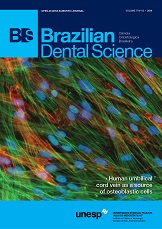Culture and molecular analysis of Enterococcus faecalis and antimicrobial susceptibility of clinical isolates from patients with failure endodontic treatment
DOI:
https://doi.org/10.14295/bds.2014.v17i3.1016Abstract
Objective: The aim of this study was to evaluate the minimal inhibitory concentrations (MIC) of different antibiotic agents against to the most prevalent microorganism found in root-filled canals by culture and molecular approaches. Material and Methods: The microbial samples were taken either from thirty root-filled canals after removal of gutta-percha. Culture methods and 16s rDNA assay were used to identify the E faecails present in the samples. The antimicrobial susceptibilities of the isolates of E faecalis were determined by MIC values using the E test System and interpreted according to the Clinical and Laboratory Standards Institute guidelines. The following antibiotics were used: benzylpenicillin, amoxicillin, amoxicillin-clavulanic acid, erythromycin, azithromycin, vancomycin, chloramphenicol, tetracycline, doxycycline, ciprofloxacin, rifampicin and moxifloxacin. Results: E faecalis were isolated (7/30) and detected (13/30) by culture and PCR assay, respectively. All tested E faecalis (n=12) were highly sensitive to amoxicillin, moxifloxacin, vancomycin, benzylpenicillin and amoxicillin-clavulanic acid. Some antibiotics were resistant against E faecalis strains such as rifampicin (4/12), tetracycline (2/12), doxycycline (1/12), erythromycin (3/12) and azythromycin (8/12). Conclusion: Amoxicillin, amoxicillin-clavulanic acid, benzylpenicillin, vancomycin and moxifloxacin were the most active antibiotics, in vitro, against E faecalis clinical strains, with all the isolates being susceptible. Azithromycin and erythromycin were least effective, with none percentage of isolates being susceptible, during laboratory testing. Moreover, E faecalis were identified more frequently by PCR assay than by culture technique.
Keywords: Retreatment; Antibiotics, antimicrobial susceptibility; Enterococcus faecalis; Antibiotic resistance.
Downloads
Downloads
Published
How to Cite
Issue
Section
License
Brazilian Dental Science uses the Creative Commons (CC-BY 4.0) license, thus preserving the integrity of articles in an open access environment. The journal allows the author to retain publishing rights without restrictions.
=================




























